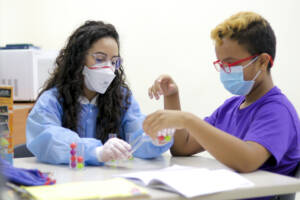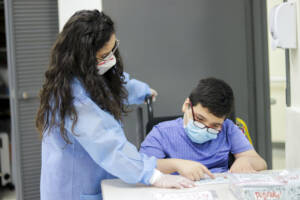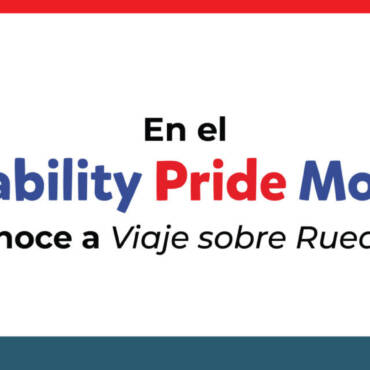Content by: Yarimar Marrero Rodríguez
According to the World Health Organization, an estimated 2.4 billion people worldwide have a health condition that could benefit from rehabilitation services such as occupational therapy. At SER de Puerto Rico we have specialized professionals and state-of-the-art equipment to provide our participants with a comprehensive rehabilitation service. To learn more about this practice, we talked with the Occupational Therapy supervisor at our center in San Juan, Angélica Rivera Miranda, who has worked for the Institution since 2013 and has held the position of supervisor since 2019.

YMR: What is occupational therapy?
ARM: Occupational therapy is the therapeutic use of daily occupations with the purpose that that person can be functional. We want people to be able to become independent again in all the activities that are significant to them. In the case of children, we work to develop these skills, if they have a delay due to a condition or lack of exposure. The nine occupations are: activities of daily living, instrumental activities of daily living, health management, rest and sleep, education, work, play, free time, and social participation. Occupational therapy is a very versatile discipline that can join different professions to nourish each other.
YMR: Who are the professionals who offer the service?
ARM: As professionals we have occupational therapists who in Puerto Rico are at the master's level and occupational therapy assistants who are at the associate degree level. These two professionals are the ones who provide the service. What is the difference? The occupational therapist has the evaluation component and the analysis component of the needs of that participant, he is in charge of establishing a treatment plan. The assistant works in the intervention process, in offering intervention activities and strategies in order to meet the needs of that person. We work together and always establish goals and objectives in that treatment plan according to the needs and the diagnosis so that the person is functional.
YMR: What evaluations are carried out at SER in this area?
ARM: We are working with the pediatric population either before a school process or while at school. We also serve the adult population, from young adults to older adults, either due to an acquired condition or from birth. We do functional evaluations to see if the participant completes these daily life skills, to establish what I can work with a series of protocols and tests.
YMR: Which ones are usuallyr diagnosed themof the people who receive occupational therapy at SER in Puerto Rico?
ARM: We have children with cerebral palsy, autism, developmental disabilities, neurotypical children but who have some delays such as attention deficit and hyperactivity, learning disabilities, sensory processing deficiencies, children with down syndrome, children with genetic conditions that sometimes they are yet to be diagnosed. In the adult participants we have people with head trauma, with cerebrovascular accidents, people with neurological conditions such as Parkinson's, muscular dystrophy with its different variants, and also people with age-acquired mobility problems.

YMR: What technological equipment (robotic technology) does the institution have and which are used in occupational therapy?
ARM: At SER we use the Rapael system in occupational therapy, which is made up of three pieces of equipment: Smart Pegboard is an interactive board with pegs (wooden sticks) with some games and at the end of the game you get a score. Smart Glove and the Smart Board. We also have the Armeo Spring Pediatric equipment and the REAL virtual reality system. The Armeo is used for coordination, mobility and integration of an upper extremity that is affected, understand an arm. Technology is here to stay and we must use it to our advantage, but it will not replace the analysis potential of the occupational therapist. SER as an institution has excelled with robotics and technological equipment and highlighting that is very important.
YMR: How do you see the future of occupational therapy?
ARM: I think that at a general level we at SER receive many occupational therapy students and they are increasingly coming out with more empowerment and with all the current issue of social networks they are giving a push for people to know more about the profession because it is still He is very unaware of everything that the profession encompasses. By making the profession more visible and having these young people who want to expand a little more and not be within a certain service drawer, they also provide space for a service focused on prevention, in community programs to create care proposals and that is happening with the movement that we are seeing at a social level in Puerto Rico and in other parts of the world. Something that I see in the future and that could even be a concern is that, on the other hand, some subspecialists are being lost within occupational therapy. There are fewer and fewer occupational therapists specializing in mental health. Right now there are few hand specialists and if they are fewer and fewer, there are also fewer who teach the next generation of therapists. As in everything, we have very good things for the future in our profession, but we also have to be aware of what is staying.
YMR: 8. From your experience in direct service, is there any particular anecdote with some of the participants that you find significant?
I always have this very meaningful anecdote when I started working here at SER, I had been around for three months, I was brand new and a participant arrived on a stretcher to be evaluated and I thought, now what do I do? I remember that she was a girl almost the same age as me, she already had children and she was in that state due to an accident in four track. There was some minimal movement, he had head trauma and still had swollen areas. Starting with her was very significant, doing an evaluation process purely with observations. One of the good things we had is that the physical therapy partner and I were able, along with the supervisors, to take the initiative and give him the services together. We incorporated her to sit on the edge of the stretcher and we helped her in the rehabilitation process to obtain her wheelchair. He was someone who went through different stages in his rehabilitation process, but that first impression of working on such a complicated case where I also felt close to the participant was a very rewarding experience within the profession. It is also very gratifying when services are completed and you discharge some of the children you have given therapy to.

